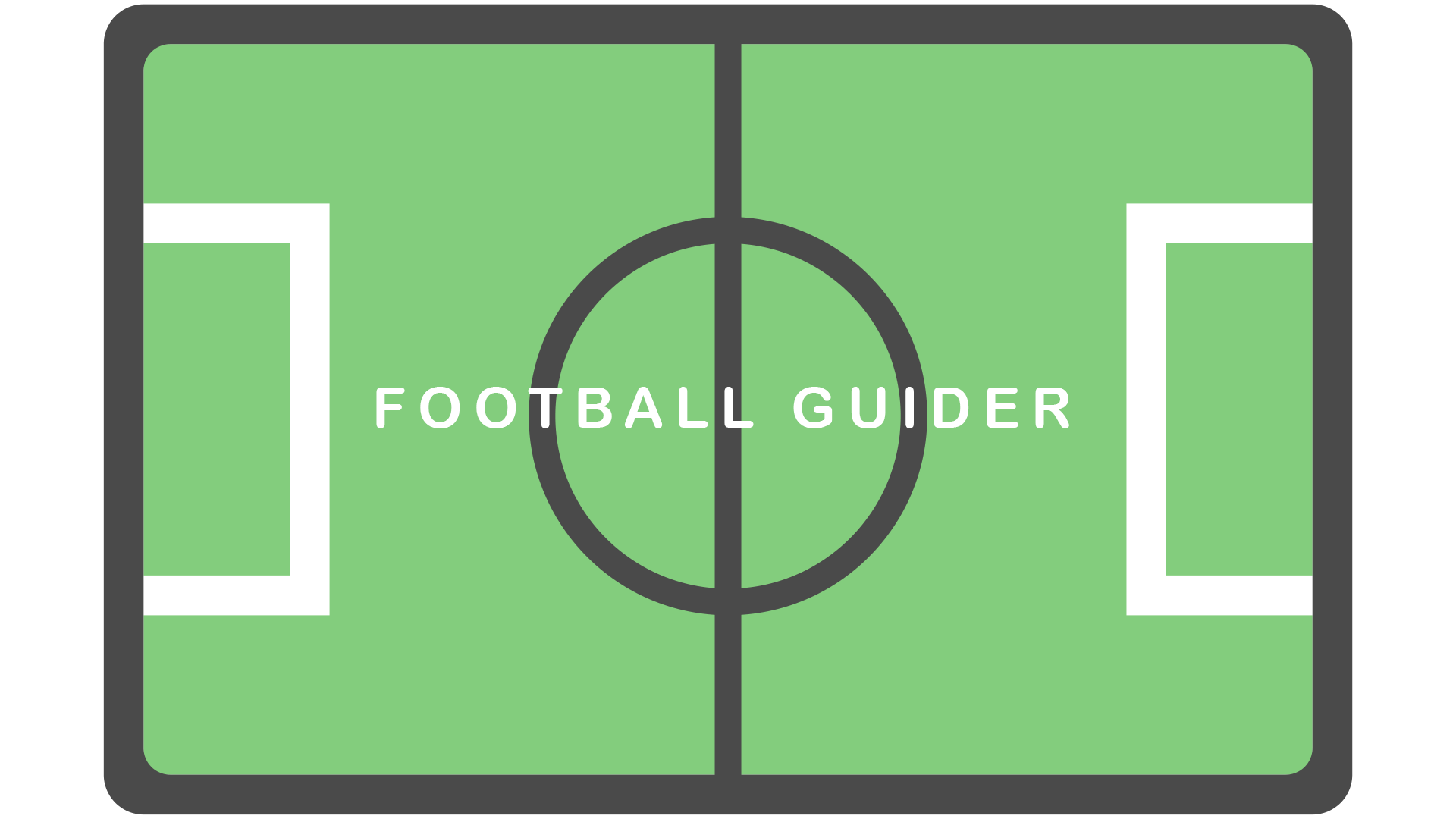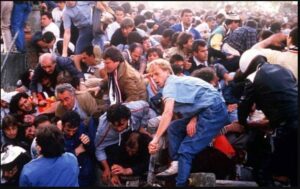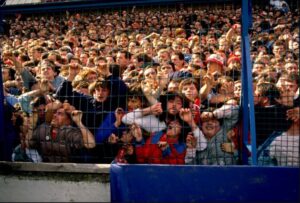Unfortunately, there have been countless stadium disasters in the football world, but all of them have contributed to other, newer stadiums being built to be safer. We thought we would put together for you a list of the world’s worst football stadium disasters so that you can perhaps gain perspective on how these major events have almost shaped football to be what it is today.
The Worlds Biggest Football Stadium Disasters
As we mentioned, we have thankfully been able to learn from these tragedies in order to make the sport much safer, for home fans and away fans alike, by learning from historic stadium failings.
1964 – Lima
In 1964, the National Stadium in Lima came to be known as the world’s deadliest football stadium disaster.
In a 1-0 Argentine lead in a Peru-Argentina Olympic qualifying match, the referee cancelled out a Peruvian goal in the last minute, causing a frenzy amongst the Peruvian fans. Police used tear gas and dogs to attempt to calm the horde of supporters, but this only caused more chaos as the fans’ behaviour forced the authorities to flee, but the stadium exits were then sealed off. The huge crowd of people tried to escape, squeezing and trampling each other, leading to 328 people losing their lives and at least another 500 others were injured to varying degrees of severity..
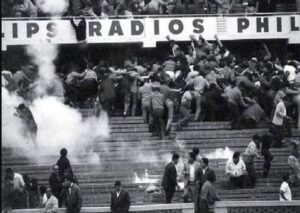
1902/1971 – Ibrox
The Scottish Rangers stadium is unique in the fact that it has housed two separate disasters within its walls:
In 1902, during Scotland vs England, one of the stands became overburdened and collapsed, sadly killing 25 people.
Further to this, in 1971, amidst a Rangers vs Celtic match tragedy struck again. Due to lack of footage, the exact events that took place were never truly revealed. But what we know comes from numerous corroborating accounts. Because the Celtic visitors had taken the lead shortly before the end, Rangers fans had decided to head home – this was in fact the beginning of what was to come. In the last moments of the match, the home side equalised.
The fans that were already on their way home learned about this through the noises coming from the remaining crowd. Upon turning around on steep stairs, it is said that someone had fell, causing a terrible resulting chain reaction. The huge mass of people completely bent the iron railings and fell into the depths of people below them. In this travesty, 66 people were killed and it is estimated that about 200 further individuals were injured.

1982 – Luzhniki Stadium
This event occurred during a Spartak Moscow-Haarlem match, at the former Lenin Stadium.
There was initially no sign or talk of the tragedy that took place here for a long time after it happened. Only 16,000 people had bought tickets for the match, despite the stadium having a capacity of 80,000. The problem was actually due to the lack of spectators and the very bad weather at the time, only two sectors of the stadium were opened and, further to this, only one exit could be taken at the end of the match.
It is said that a girl had fallen down on a set of stairs whilst making her way out and somebody had tried to help her up. But, – similarly to the second Ibrox disaster – because of the sheer moving pressure caused by the rest of the crowd who was also leaving, a lot of other people also ended up falling on the stairs. In this instance 66 fans were killed overall.
Many teenagers lost their lives in the tragedy, but the Soviets hid the entire thing from the public. The worst part about it is that even the teams that played the game didn’t find out about what really happened that day until the same time that the general public also did, a lengthy seven years later.
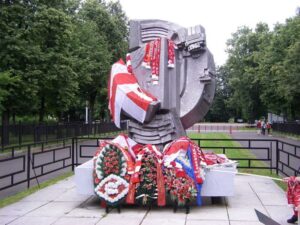
1985 – Bradford
On the 11th May 1985, Bradford City played Lincoln City in the Third Division League. The home side held the ceremony before the game as they won the third division.
The overall atmosphere and soon-to-be events of the game was said to be caused by, as theories state, a man dropping a burning cigarette butt. The grandstand had been constructed with wood and the roof was covered with bitumen – which is a highly flammable material.
The man who dropped the cigarette had apparently tried to put it out by trampling it, but it fell between the boards and then underneath the stands, where a lot of garbage had accumulated over time. Various accounts go on to say that the man and his son then tried to put out the cigarette by pouring coffee over it, but to no avail as it wasn’t very effective, it was then that they finally called security.
There was chaos for those who fled, because the gate had been closed, many of those who tried to make their way to it lost their lives. 56 people were killed and another 265 got injured.
The most ironic part of this situation is that the fact that the stand had burned down at the end of the season – ironic because Bradford City had in actual fact planned to renovate the main stand for the next season.
Furthermore, this specific tragedy contributed significantly to the development of all other stadiums as, following the incident, it became forbidden to build stadiums in this way in England.
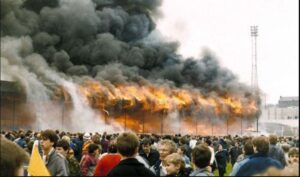
1985 – Heysel
Perhaps the most famous stadium disaster in the world was the 1985 Heysel stadium tragedy. This took place at the rather poorly conditioned Heysel stadium in Brussels, during the Champions League final of the year, where Juventus and Liverpool clashed.
The Belgians had made countless mistakes, as many people entered the stadium without tickets and the preparation of the police wasn’t adequate. The problem was that the sector dedicated to Liverpool’s fans was overcrowded and, in the meantime, Juventus supporters could be seen waving flags in the neutral sector. The Liverpool side began throwing items and escalated the situation even further, attacking the Italian fans, who were forced to flee.
Initially, about 5-8 police officers had tried to stop the hooligans, but later the situation had only marginally improved, barely having much of a difference to the earlier display. Then the trouble began – the retaining wall of the grandstand broke away, 39 people lost their lives in the tragedy and several people were injured, although it is said that the panic was over quickly.
All of this happened before the match, but fearing that the postponement would cause even more chaos, the game went ahead and Juventus won the match 1-0 with Platini’s penalty goal.
Following the tragedy, UEFA banned English teams from international competitions for five years and made Liverpool fans clearly responsible.
1989 – Hillsborough
During the Liverpool vs Nottingham Forest FA Cup semi-final, the organisers had made a number of mistakes. In sectors 3 and 4 there were well over the limit of 1600 people allowed, with actual number equating to about 4000 people.
Moreover, with 10 minutes to go before the match was due to start, there were still plenty of fans waiting outside as police decided to open the gate originally reserved for escape. These people, however, also went to sectors 3 and 4, building up the huge crowd further.
Unfortunately the police were mostly only concerned with curbing hooliganism, as well as also trying to make sure that no one ran onto the track. People were trying to escape the sector through the bars, but many were either pushed against the fence or trampled to death. Officer David Duckenfield, who was in charge of the incident, was handing out orders to curb hooliganism and didn’t believe that the overcrowding would be capable of causing tragedy.
The tragedy killed 96 people and injured more than 700 others. A 10-year-old boy was the youngest to be killed here. His name was Jon-Paul Gilhooley and he was a cousin of Liverpool legend Steven Gerrard. The dowry of this tragedy is that the stadiums have removed the internal fences and in place of this they created seating sectors.
If you’d like to know more about this tragedy, Britannica.com have written a more in-depth article, covering the events and proceedings that followed the 1989 Hillsborough football stadium disaster.
2001 – Accra
On May 9th, 2001, the Accra Stadium in Ghana came to be a part of the worst football stadium disaster African football have ever recorded. In the 85th minute, the home team were able to take the lead. This led to the, enraged, away fans throwing fire-based weapons and begin to throw chairs onto the pitch. The police tried to take action against the rioters, who ended up fleeing, but authorities had closed the gates of the stadium in order to avoid rioting in the city and used tear gas to try to contain violence. Sadly 126 people lost their lives.
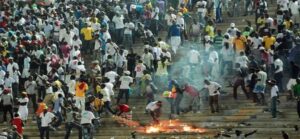
Read more from footballguider,com
